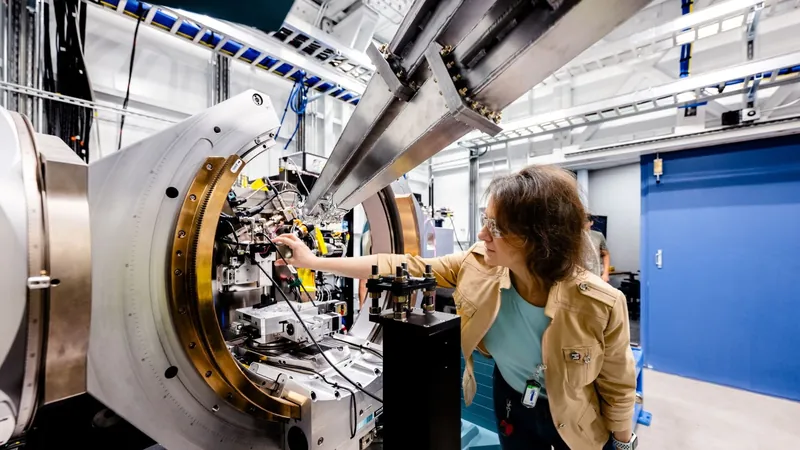
Unveiling the Future of X-ray Research: Advanced Photon Source Upgrade Set to Revolutionize Experiments!
2024-10-02
In a groundbreaking development, X-ray beams are once again illuminating the U.S. Department of Energy's (DOE) Advanced Photon Source (APS), following a lengthy year-long shutdown.
This pivotal moment marks significant progress in an $815 million upgrade project that aims to revolutionize scientific experimentation by providing unprecedented opportunities for researchers in a wide array of fields.
Located at the DOE's Argonne National Laboratory, the APS harnesses intense, directed X-ray beams to explore everything from innovative materials for solar cells and battery technologies to the intricate structures of antibodies that combat viruses.
Although the facility has resumed operations, it is still ramping up towards full power, utilizing an advanced electron storage ring to generate X-ray light by accelerating charged electrons.
Once fully operational, the upgraded APS will direct its powerful X-ray beams to an impressive 71 experimental stations, propelling scientific inquiry to entirely new heights.
The intensified illumination is expected to be up to 500 times brighter than previous capabilities, enabling scientists to deeply probe samples with greater detail than ever before.
Anticipation is high among researchers, with over 5,500 scientists annually relying on APS's X-ray capabilities.
In preparation for the upgrade, Argonne staff proactively engaged with users to better understand their research needs, resulting in a flood of proposals from eager scientists looking to leverage the state-of-the-art facilities.
The upgrade encompasses not only enhancements to current beamlines but also the introduction of seven new ones that are specifically designed to exploit the newfound brightness of the X-ray beams.
Noteworthy among them are the High-Energy X-ray Microscope (HEXM) and the In-Situ Nanoprobe (ISN), which will reside in the innovative Long Beamline Building.
The ISN will provide previously unreachable capabilities for observing materials, particularly those relevant to battery technologies, while adapting to varying environmental conditions.
Meanwhile, HEXM's expansive 180-meter beamline will allow researchers to study materials under extreme conditions, such as those encountered in aerospace and nuclear energy applications.
Dr. Jonathan Almer, a physicist at Argonne, explains, “Sample cross-sections were previously limited to one millimeter. Now, we can increase that size significantly, offering users more representative samples of real-world conditions.”
This expanded capacity will also enable researchers to focus the beam down to less than one micrometer, enhancing the resolution of investigations.
In the realm of materials science, Ashley Bucsek from the University of Michigan is keen to explore the mechanical properties of metals using HEXM.
“This unique facility will facilitate the study of larger samples and heavier elements, allowing us to closely investigate the origins of cracks and the lifecycle of materials.
By zooming into the rare occurrences of material failure, we can uncover critical insights that inform safer engineering practices,” she stated.
Adjacent to HEXM, the newly established Activated Materials Laboratory will enable secure experimentation with nuclear materials, significantly improving safety and efficiency in handling such sensitive substances.
Another promising addition to the APS repertoire is X-ray Photon Correlation Spectroscopy (XPCS), which will empower scientists to investigate the behavior of liquids, gels, and quantum materials at a molecular level.
This capability is expected to contribute invaluable knowledge to fields such as energy-efficient technologies, battery chemistry, and drug delivery systems.
Incorporating advances in rheometry, the XPCS beamline will allow researchers to measure how fluids respond under various forces with unprecedented precision, shortening experimental timelines from days to mere hours.
Dr. Jeffrey Richards from Northwestern University notes, “The upgrade fundamentally changes not only how quickly we can process samples but also expands the range of materials we can study.”
Beyond these exciting innovations, the existing APS beamlines are set to experience transformative improvements.
The GeoSoilEnviroCARS (GSECARS) facility aims to deepen our understanding of Earth’s geology by recreating extreme planetary conditions, allowing for insights into seismic activity and planetary formation.
With installation of the upgraded electron storage ring now underway—after more than a decade of meticulous planning and engineering—scientists are gearing up to utilize the enhanced capabilities of the APS.
As project manager Elmie Peoples-Evans reflects, “This project could only succeed with the commitment and collaboration of everyone involved. Now, we’re ready to propel our users back into groundbreaking scientific exploration.”





 Brasil (PT)
Brasil (PT)
 Canada (EN)
Canada (EN)
 Chile (ES)
Chile (ES)
 España (ES)
España (ES)
 France (FR)
France (FR)
 Hong Kong (EN)
Hong Kong (EN)
 Italia (IT)
Italia (IT)
 日本 (JA)
日本 (JA)
 Magyarország (HU)
Magyarország (HU)
 Norge (NO)
Norge (NO)
 Polska (PL)
Polska (PL)
 Schweiz (DE)
Schweiz (DE)
 Singapore (EN)
Singapore (EN)
 Sverige (SV)
Sverige (SV)
 Suomi (FI)
Suomi (FI)
 Türkiye (TR)
Türkiye (TR)